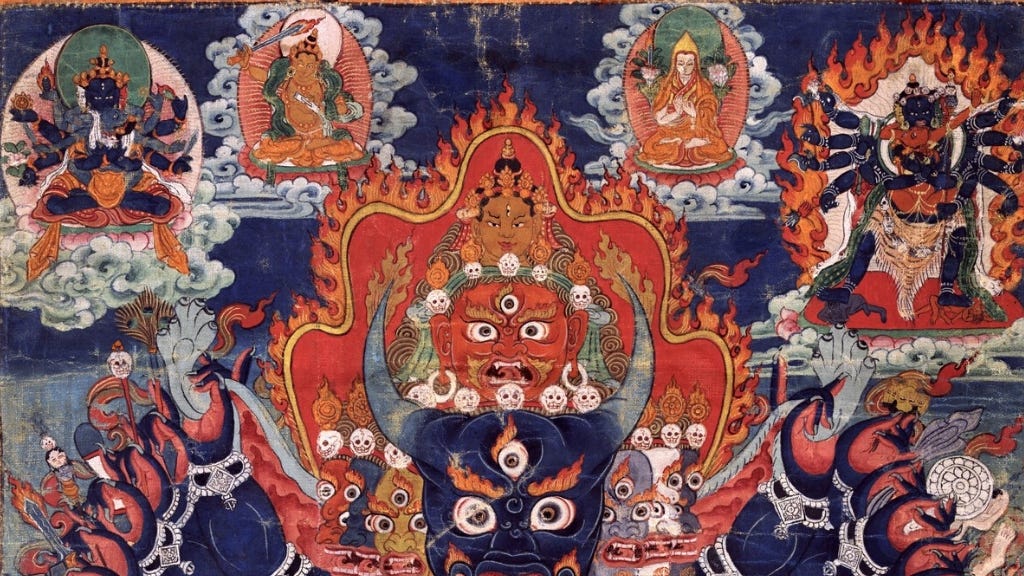By Jim Miller
What do the classics have to teach us about the meaning of suffering, near-death, and death?
Beginning with my diagnosis of acute liver failure this summer, all the way through transplant surgery and neurotoxicity from one of my anti-rejection medications, my multiple near-death experiences encapsulate what Tibetan Buddhist nun, Pema Chodron, in her book How We Live Is How We Die, defines as a “bardo” or transition, which comes from the Bardo Tödrol or The Tibetan Book of the Dead.
This text, as she writes:
Eventually . . . was more openly taught, and in the 1920s, an American anthropologist named Walter Evans-Wentz organized its first publication in English with the inaccurate but alluring title The Tibetan Book of the Dead. It became wildly popular in the West. In the 1960s, it was taken up enthusiastically by the hippies, of which I was one. It continues to be one of the most widely taught Buddhist texts on the bardo.
As Chodron observes, the term bardo, “commonly refers to the passage following our death and preceding our next life.” She goes on to say:
. . . a broader translation of the word is simply “transition” or “gap.” The journey that takes place after our death is one such transition, but when we examine our experience closely, we will find that we are always in transition. During every moment of our lives, something is ending and something else is beginning. This is not an esoteric concept. When we pay attention, it becomes our unmistakable experience.
Bardos, then, are states of “continual change,” a “continual flow of transitions” from one thing to another.
I was dying. And then I wasn’t. Now I am on the way to recovery. But having previously read Chodron’s book before my acute health crises, I am aware that even with new medications to control the worst of my symptoms and make sure my body doesn’t reject my new liver, for the next year and onward, every moment is precious, indeed, every second. The future is always uncertain, becoming and ending and becoming again.
We can see many other examples of cultures trying to come to terms with our finitude or ultimate limits in a wide range of philosophical and/or religious traditions from early creation stories, ancient cave paintings, and the Judeo/Christian tradition, to existentialism, the works of Kierkegaard, Freud, Bataille, Lispector, Kubler-Ross, and many more. They all tell us that there is meaning in suffering and death, and furthermore, that we would not have any meaning at all without them.
But, at present, we are living in a Brave New World, as Aldous Huxley labeled his dystopian novel, where everything that is not instantaneously pleasurable is left to the margins of the culture where the notion of tragedy lives on a “savage” reservation alongside other quaint anomalies like meaning and transcendence.
“Whatever,” shrug Tik Tok and Instagram.
As Chodron goes on to outline, although “we are not in control” and are forced by circumstance to recognize that “stable, solid reality is an illusion,” what the bardo teachings illustrate, according to her, is that deeply engaging with “impermanence” and “all pervasive suffering” does not inevitably lead to despair but puts us face to face with the “wonderous flow of life and death.”
They guide us to an openness to reality and continual change, then “how we live will be how we die,” seeing the flow at the center of a universe where “everything falls apart,” while still enabling us to admire the joy and beauty at the heart of the dance of life and death. We can stop our constant running away from and resisting reality and adopt “a new way of seeing our [lives] as dynamic and vibrant, an amazing adventure.”
Perhaps putting this into political terms, it means centering compassion and patience as core principles rather than calculation and winning at the expense of our humanity. Upon much reflection over the last several weeks, I have come to see many of my own shortcomings but also realized that deep alienation and dehumanization are what ail us at the individual and collective level.
We need to be better and not be, as one of the Founding Fathers once put it, “wolves to each other.”
A simple bit of ancient wisdom, but it needs to be the first thing we do if we are ever going to muster the courage to save the earth from ourselves and choose community over chaos.





So then, who is the tathagata? -- the one who simply comes and goes, now dying, now not dying, now recovering, now musing, now co-responding?
Here's what old Kalu Rimpoche had to say about this, first as translated from the Tibetan original into English in the form of a block, and then as re-visioned in verse, by a couple of his disciples:
You live in illusion and in
the appearance of things.
There is a Reality. You are
the Reality. But you do not
know it. If you wake up to
that Reality, you will know
that you are nothing, and,
being nothing, that you are
everything. That's all.
-------------------------------
We live in illusion,
in the appearance of things,
oblivious of reality --
oblivious
of who we really are.
When we wake up
to who we really are
we know we are nothing,
and as nothing,
everything.
That's it!